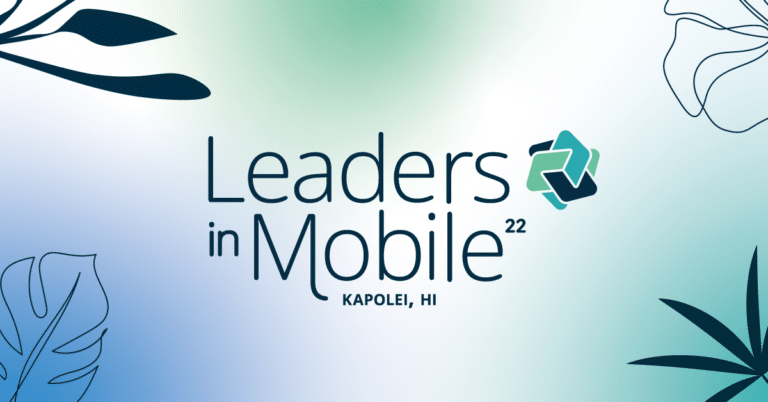Leaders in Mobile (LIM) is an invite-only community that brings together cross-functional movers and shakers from some of the top companies in mobile. At the recent LIM retreat in Kapolei, Hawaii, attendees exchanged ideas and discussed how mobile has shifted and where it’s going next.
I’ve participated in many roundtables during my time in the mobile industry, but these were some of the most sophisticated, insightful conversations I’ve ever had. In this post, we want to share a few key insights and takeaways, including strategies on how to grow, measure, and retain your mobile app users.

Find ways to make your app attractive and sticky for users
Differentiation is key to making your app stand out. One good option for this is personalization, which can be used for both user acquisition (e.g., via personalized content, including content generated by other users in the app) and effective engagement (e.g., gamification of the app experience).
However, while personalization has been a key differentiator for driving growth, rigorous testing to confirm its effect is crucial. Deploying personalization at scale is also a challenge, and some companies are looking at systems powered by machine learning as a way to accomplish this.
Gamification can also help with differentiation, but it’s difficult to get right. Even agreeing on the definition of ‘gamification’ is hard. The challenge is finding a gamification strategy that actually fits with the app or product rather than simply relying on giving referral discounts or monetary incentives.
It’s more important than ever to control your own data
With the continuing reduction in data signal, due to new regulations and changing platform privacy policies, having a first-party data strategy is increasingly important. This includes controlling and centralizing your own data so it can be used effectively throughout your organization as a competitive advantage. Data centralization — considering how to both collect and standardize inputs from multiple external channels, as well as how to distribute consistent data across the company — has always been a challenge, but it has become much harder in part due to iOS privacy changes.
Loyalty programs can be a useful key tactic to control your own data, but the continuing interaction over time must feel authentic to your customers, as well. Implementation decisions also matter since third-party management of loyalty programs can result in loss of data control.

Data is now less reliable and complete now than in the past
There is no doubt attribution data is now less reliable and complete. This is in comparison to what was available prior to iOS 14 and also to Apple’s introduction of the AppTrackingTransparency (ATT) policy. What’s less clear is whether there ever was a ‘golden age of attribution’, because no one was ever completely satisfied with their mobile attribution data in the first place. The old systems already ignored a lot of gaps, and no one totally trusted them.
Still, the gaps have become more prominent with increased lack of data signal, especially from iOS 14 privacy changes. This has led brands to question if paid ads are worth the investment now that targeting and proving ROI is more difficult. Advertisers agree it’s important to maximize the signal they’re getting from a limited amount of data, but the path forward isn’t clear. The new world is harder for smaller companies to navigate, and it will get even harder from this point forward.
When it comes to prompting for ATT opt-in permissions, the timing of when to make the request, and how to embed it into the user journey, is critical. This is because it’s important to ensure you hit at the right time to maximize the likelihood of a positive user response. This right time could be different for different cohorts, and activation actions can differ more based on user goal than user profile.
New measurement approaches may help but require major changes
In recent years, performance marketing on mobile has become a precise, metrics-driven science. With the ongoing disruption of data signal, in some ways we are returning to a simpler time and bringing back the art of marketing.
As people are trying new options to centralize their data, new approaches to measurement have promise. These include media mix modeling (MMM), incrementality, and data clean rooms. But these approaches will also come with their own challenges. In reality, it’s hard to trust black boxes, especially when justifying to other stakeholders. However, there is some good news. These new measurement approaches may open up more non-traditional growth channels that previously weren’t measurable, and, therefore, not considered.
There are still many challenges to work through with all these new solutions. Most brands are looking for ways to minimize the gap during this transition period. Media mix modeling requires a huge amount of data, and most smaller companies don’t have enough of it to build a usable model (at least, using traditional MMM techniques). Many brands feel it’s important to start collecting whatever data they can now, to make it possible to build differentiated models before everything disappears.
Despite these challenges, iOS users are still considered more premium. Privacy changes may be making it harder to reach them, and they may no longer be reliably more valuable for ad audiences than Android. But brands are not ready to throw in the towel on iOS users yet.

It’s no longer cost-effective to fill the bucket without fixing leaks
With the increasing difficulty and cost of user acquisition, throwing money at the top of the funnel via ads, influencers, or discounting isn’t always the answer to increase user base. Instead, it’s critical to focus on retention and reengagement for the users you already have. And because it’s very hard to bring back churned users unless you know why they churned, it’s important to find people who are already ‘on the bubble’. In fact, sometimes the most effective option is to reuse your existing top-of-funnel or brand content (like info on new product improvements) with existing or churned customers. Or use basic, FOMO-based messaging, like a subject line that says ‘Pending’ or ‘New in your membership’ to bring users back.
The truth is, with the attrition of device IDs, the yield on paid reengagement is low, and it’s becoming even more difficult. Most now agree the future of ad targeting is contextual — at least until the implementation of next-generation technologies like Topics and FLEDGE in Privacy Sandbox. And it’s almost impossible to reliably find your existing (or churned) users via contextual targeting. This makes it much more difficult to justify paid reengagement campaigns. Some brands are no longer bothering to run them for iOS users at all.
Discounts bring new customers, engagement, and headaches
Discounting can seem like an easy fix, but companies and customers risk getting addicted to it. Once you start discounting, your customers expect it to continue. Discounts and coupon codes are rarely a first-choice strategy, but if others in the space are doing it, companies can be forced to play along despite concerns about how discounting affects the value of their brands.
Discounts tend to be more important at the lower-cost end of offerings, while premium product buyers usually don’t care about getting a deal. Customers say they want traditional ‘dollars-off discounting’, but for many brands, using discounts to add value or encourage adoption of more products is a better strategy. Ideally, determining the value of a user via A/B testing or other strategies and providing a custom discount code to that individual is preferred over handing out the same discount to everyone.
Some level of discount fraud exists for nearly everyone who uses discounting as a strategy. Companies are monitoring this and combating it with limits, single-use codes, monitoring for duplicate accounts, and, in some cases, geohashes and AI to detect suspicious behavior. Codes that leak and go viral are always a challenge, but if the code doesn’t hurt your business, sometimes it’s okay to let it go. In fact, sometimes brands are ‘hacking the hackers’ in that the perceived value can go a lot further if customers think they found a secret.

Appetite for alternative and experimental growth channels increases
Measuring the ROI of experimental growth channels has always been more difficult than paid advertising. However, measurement of ads is also harder today, which helps make alternative growth hacks easier to justify.
Given all the changes in the world, what is old is new again. Brands have tried everything from programmatic direct mail services to send cards in the mail to hiring a plane to fly a banner. And the effects of campaigns like these can be amplified when people are incentivized to extend reach on social media. Tactics like gamification, referrals, preloads on new devices, and influencer marketing/ambassadors are all directions brands are considering.
Referrals are a popular and increasingly important channel but need care to get right. The incentive has to be enough for users to see the value in recommending to their friends. And while monetary rewards are the easy choice, they’re often not the most effective. Other options that can work better include gamification, physical gifts, or special VIP-type access to things. Pairing up with another app to access their audience through cross-promotion is another great way to access a new audience.
Web-based SEO is also increasingly important as an acquisition channel for brands with native apps. But the shift from technical SEO to content-driven SEO opens the door for new questions around what makes good content and how to turn content visits into app users. (Web-to-app banners are a popular solution!) Also, a content-driven strategy may not be relevant to every vertical. For example, should you generate content if you’re a utility-type app?
If you’re going to experiment, you have to be in an interactive mindset. This is because digital attention constantly shifts. The things you did a couple years ago will not work today. TikTok is often cited as an example where very unintuitive videos do well compared to the viral videos of yesteryear. You also have to be ready to scale a campaign once you find something that works. For example, if a PR article hits, or a viral post starts to scale, be ready to push it out to all channels within minutes. Taking even one day could cause you to miss the opportunity.
Measuring an experimental campaign is done in a variety of ways. Those with more tech investment can utilize MMM (even the more traditional solutions available today). But other, faster ways include monitoring direct/organic traffic around the time/geo of the campaign to observe the lift.
Apps are now just one part of a broader brand <> customer relationship
For many brands, making the app part of the broader customer relationship — not just a destination of its own — can extend its value. Physical campaigns like QR codes help drive conversions, and it makes sense to use them everywhere, such as on receipts, boxes, menus, coupons in mail, flyers, and so on. User-generated content (UGC) is another great flywheel for understanding what users care about. UGC has the added benefit of providing ready-made raw material that brands can use to enhance marketing campaigns.
Freemium models can also be used as part of an acquisition strategy, but it’s important to consider how much to give away for free. To determine this, you need to understand how customers are using the product during onboarding. However, it is important to do this carefully since the collection of more information could impact conversions. Freemium models can also help to identify champions that assist in building audiences.
Finally, not every brand has the same goal for app engagement and marketing campaigns. Sometimes app installs are the goal, and sometimes the goal is to drive as much ongoing engagement as possible. But in other cases, not all app engagement is good. Some brands grapple with finding ways to engage customers without unintentionally reminding them to cancel a subscription. Or they grapple with keeping costs in control with the right level of interaction when more app usage equals more costs.

Bring teams together with flexibility for comfort levels
The post-COVID adjustment is challenging for every organization to manage, not just in mobile. COVID has affected trust and engagement, making it much harder to connect and feel unified. Many people moved to other time zones during the pandemic, which has made it harder to meet both in person and even virtually.
Collaboration itself has changed, too. Many teams are having new discussions about how to best use Slack, Slack threads, meeting pre-reads, and Zoom meetings. (No one has yet discovered a good solution for Zoom meetings where some participants are in a room while others are remote!)
Most leaders want people to come back to the office to foster innovation and creativity, at least occasionally, but it’s hard to find what motivates their teams to do so. And the lack of clarity on company policies creates uncertainty that is hurting retention. Some companies report losing their best talent because of a too-strict policy on office work. This is why it’s key to meet 1:1 before making a request for anyone to return to office.
New hybrid work models are also emerging. Rather than requiring a regular in-person office presence, some companies are experimenting with monthly, quarterly, or annual get-togethers as a way to build bonds. Companies reported these are becoming a lot more fun and activity-based, rather than being about working together in the same location.
Want to join the conversation?
If you would like to apply to join the LIM community or find out more about upcoming LIM events, please email [email protected].






















